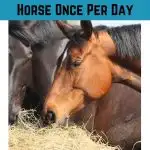Sometimes life gets busy and, for whatever reason, you can only feed your horse once per day. Maybe you are going out of town and have someone checking on your animals once a day. Perhaps you have to take an overnight trip or a loved one is sick and you know you won’t be back. How do you make one feeding last all day for your horse?
Can you feed your horse once a day?
You can feed your horse once a day as long as you make sure that the horses has enough feed. You will want to use a slow feeder or automatic feeder to ensure the feed lasts at least twelve hours if possible.
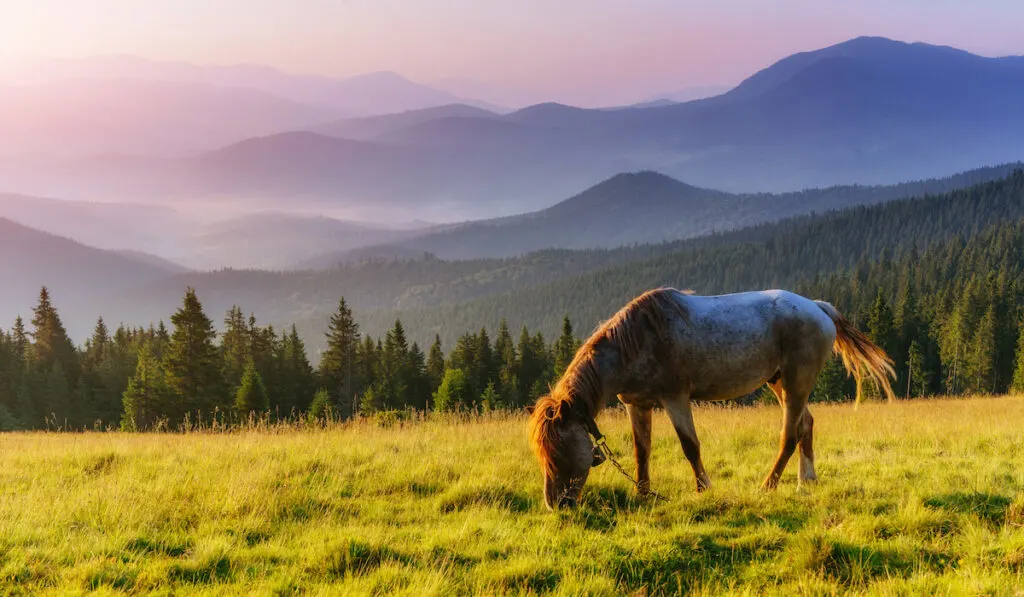
Feeding horses at least twice a day is standard and the ideal situation is for them to be able to constantly have access to food as they would in the wild. When given the opportunity, horses will spend 60 -50% of their day grazing. That is up to 17 hours eating in a 24 hour period (source).
The more times per day you can feed your horse, the more natural it would be for him. Three times a day is better than two, four times is better than three. If you need to feed your horse just once per day, these tips will help you do just that.
And note that, in our related article on giving a horse beer for colic, we discuss how the actual diet can have a lot of effects, and how specifically swapping from high moisture grass to hay can cause a colic episode.
Table of Contents
Why You Should Use a Hay Net
Hay nets are awesome for slowing down the rate your horses consume their hay. Several different types of hay net are commonly sold. The size of the holes in the net determine how slowly the horse is able to consume the hay.
The smaller the hole in a hay net, the slower a horse will be able to consume the hay. They have to work harder to get the hay out. As the holes in the hay net get larger, it is easier for the horse to get the hay out and so, the hay is consumed more quickly.
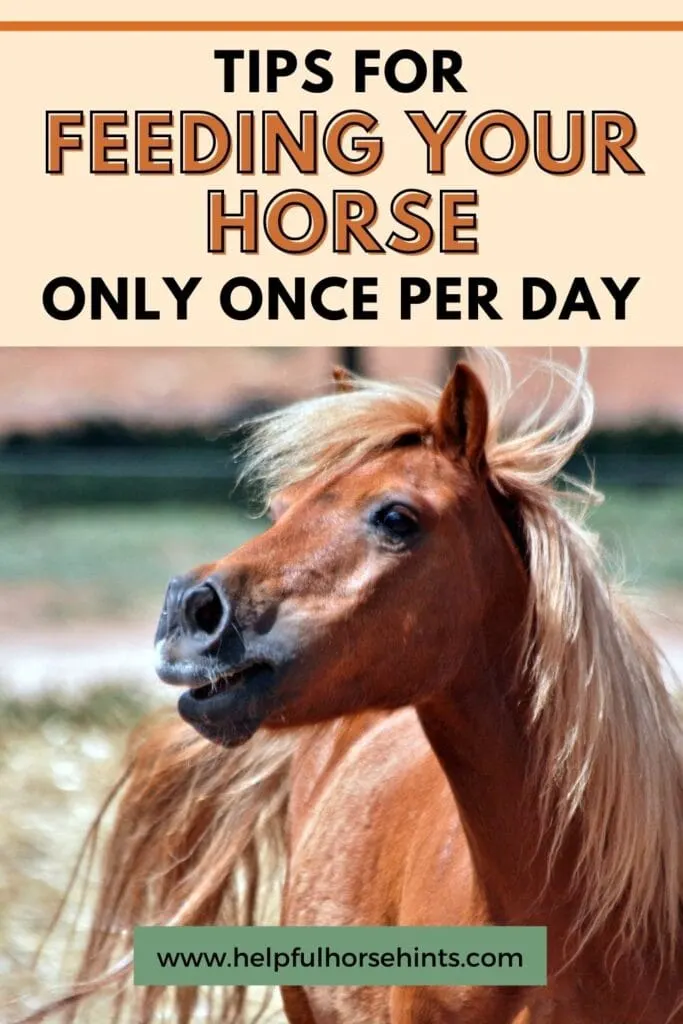
Teaching Your Horse to Use a Hay Net
Typically, you’ll want to start your horse with a larger opening to get them used to eating from one and then move them into one with a smaller opening once they get the hang of it.
This hay net This hay net on Amazon is pretty economically priced and works great for teaching horses how to eat out of a hay net. Once your horse is doing well with that, I like this hay net for continued normal use.
When I had horses and burros at my house, I would try to feed them all from hay nets whenever possible. I prefer to have horses eating off the ground as well as encouraging them to forage throughout the day.
Feeding once a day using hay nets is doable but you will want to make sure your horse has several hay nets filled so that they last an adequate amount of time. I would recommend at least three and, if possible, hang them in three different locations.
If your horse has a square pen or box stall, for example, add one on the front wall, one on the back wall and one on a side wall. This will encourage your horse to move from spot to spot as well.
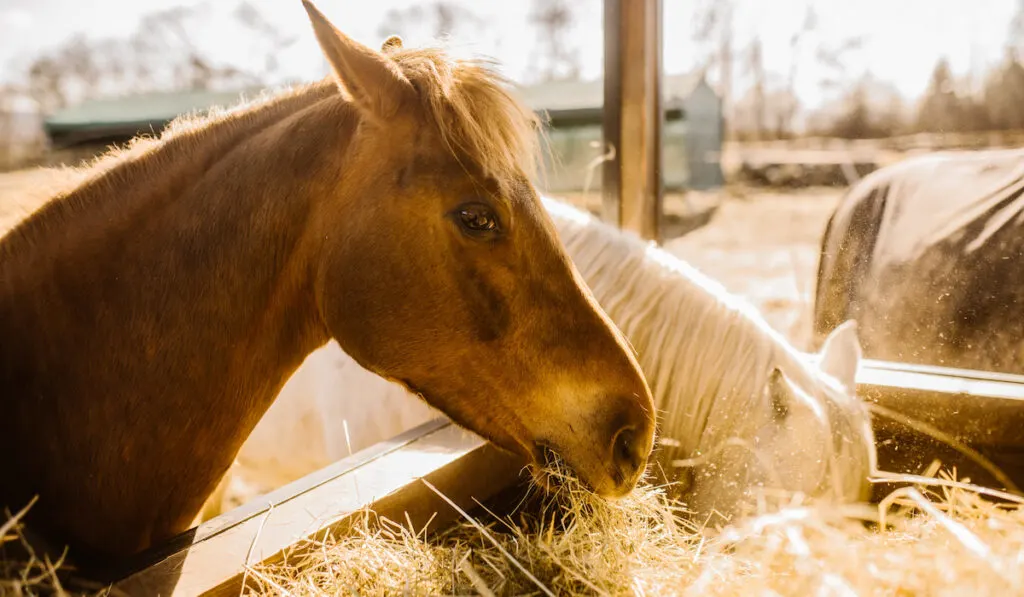
How Much To Feed
If you are feeding your horse once a day, you want to make sure your horse is getting adequate nutrition. You need to make sure he is getting enough hay to meet his daily requirements.
How much hay should a horse eat? According to LSU, a mature horse will eat 2 to 2.5% of its body weight a day For a 1,000 lb horse, that is 20 – 25 lbs of hay each day.
When you need to feed once a day, it is best to increase the amount being fed to ensure the horse has hay available for most of the day. A horse that is fed all of its daily ration at once may gorge on the hay first thing in the morning and then be without food most of the day. According to LSU, this can lead to an increased risk for Gastric ulcers, which you definitely want to avoid.
In my case, when I had to feed once per day, I doubled the ration for the horse. Typically I’d use 1 hay net for each feeding and make four nets if I was going to be gone all day.
Often, the horses had feed left over, but I knew that they were adequately fed all day. If you have to routinely feed your horse once per day, you can play with the amounts you give and optimize it to fit your horses individual needs.
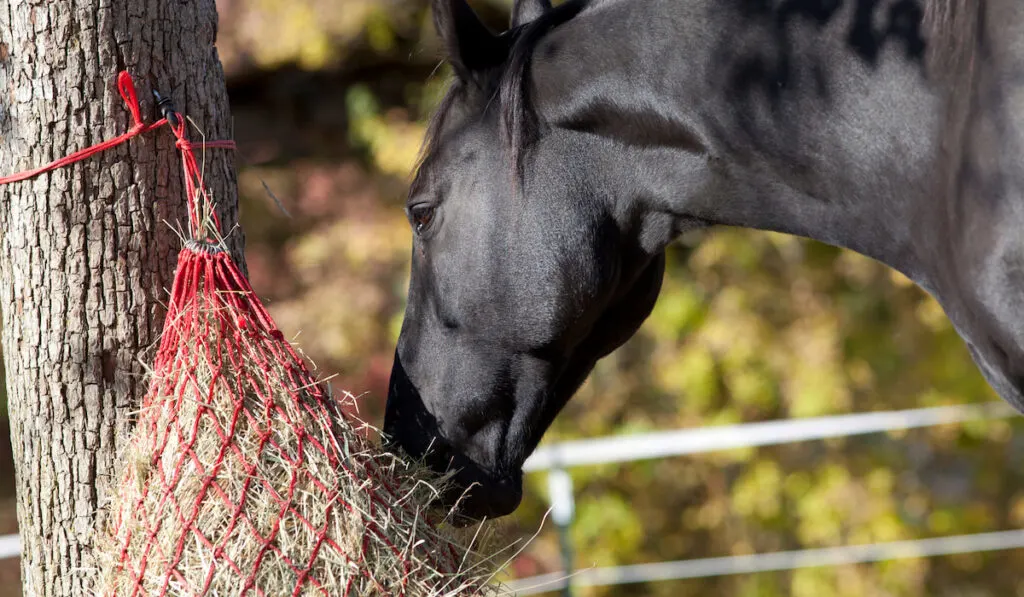
Safety Considerations
- Anytime you use a hay net, you want to make sure it is secured in such a way as to avoid injury to the horse. The best way to do this is to tie it high and tight so that, when empty, a horse is unlikely to get a leg through it.
- Instead of fastening a hay net directly to the stall wall, use a small piece of bailing twine as a breakaway. That way if your horse does get caught, the twine should break allowing the net to drop to the ground.
- Some horses will eat the hay net. If your horse does this you may want to find another solution. Note that it is normal for hay nets to need to be replaced ever so often as impatient horses will often bite at the net if food isn’t coming out fast enough for them.
Feeding Multiple Horses in a Group
If you are feeding multiple horses in a group, but can still only feed them once per day at the most, consider getting a larger hay net. They do make hay nets that accommodate entire bales of hay.
You’ll still want to make sure there is enough hay in the bale for each horse to get it’s minimum ration AND enough so that they have hay for most of the day.
In California, 100 lb hay bales are common and I would typically feed 1 bale per 3 – 4 horses if I had to feed once per day.
With these, hanging them isn’t really feasible so I’ll put the bale in the net and then place the whole thing in a big feeder. This helps to prevent horses from pawing at the hay net or possibly getting a shoe caught in the holes.
You can find good bale nets for sale on Amazon. I like this one a lot.
Automatic Horse Feeders
If you will routinely need to be away from your horses throughout the day but want to ensure they get adequate feed, consider an automatic horse feeder.
Prices vary depending on the type. There are some on the market that will actually dispense hay flakes at varying intervals but these types tend to be thousands of dollars.
Instead, an economical option is to get an automatic feeder that dispenses pelleted feed. Most commonly you would use these to dispense plain hay pellets as sticky feeds, like sweet feed, can bind and get caught.
There are several on the market and these may be a great option if you only have a couple of horses at home and want to make sure they are fed at regular intervals.
The one I found that I would like to try is the QuickFeed Feeder. It has great reviews AND holds 50lbs. 50 lbs could last a couple of days if need be which means you will be filling it less often. Just the reduction in farm chores would be worth it. You could even feed in the morning and set it to only feed at night if you are feeding once per day.
The QuickFeed unit comes in two types, a single horse model and a double horse model. You can find them on the manufacturer website.
Final Thoughts
The great thing about hay nets is that, because it contains they hay, there is typically much less waste. Even though you may be feeding more, there is a better chance it is all getting in your horse versus being walked on, peed on, etc.
Hay nets are great for day to day use for most horses but they can be especially useful for those times when you can only feed your horse once per day. Just remember to take adequate measures to make sure your horse has enough feed and water to get through the day.
If you liked this article, you may find the following articles interesting:
- How to Choose the Right Size Horse for Your Height and Weight
- 10 Easy Horse Obstacles Under $20
- DIY Custom Stall Sign
- Rodent Control for Your Barn
Resources:
- https://www.lsu.edu/vetmed/ehsp/horse_health/aaep_tips/hay.php
- https://lsu.edu/vetmed/ehsp/horse_health/aaep_tips/gastric_ulcer_risk.php

